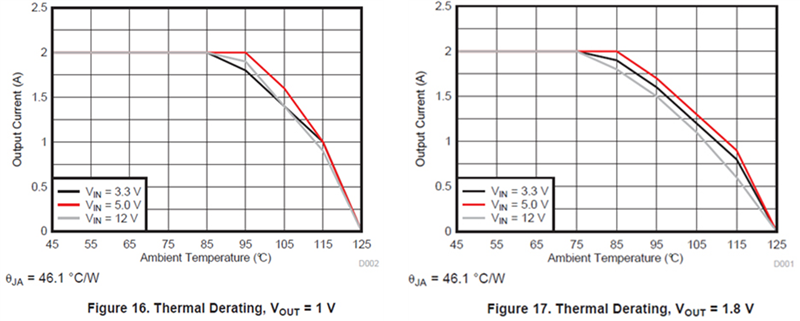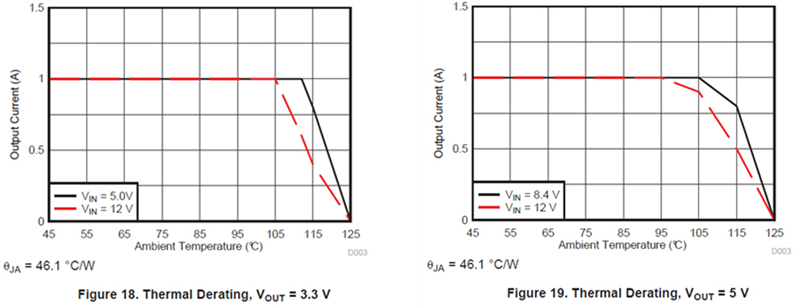SSZT986 august 2017 TPS82130 , TPS82140 , TPS82150

As electronics get smaller and smaller, power-supply designers must consider thermal limits when designing their power supplies. A smaller power supply is not useful if it cannot operate at a heavy load inside a specific application environment, which includes the ambient temperature.
One common thermal limit is represented in a derating curve, which you’ll find in most power-module data sheets. The derating curve shows the amount of drawable current or power at various ambient temperatures, while still keeping the power module within its temperature specification (usually below 125°C). Figure 1 shows two such curves from the 2A TPS82140 power-module data sheet.
 Figure 1 Derating Curves for the 2A
TPS82140 Power Module
Figure 1 Derating Curves for the 2A
TPS82140 Power ModuleAs Figure 1 illustrates, derating curves change slightly with changes in input and output voltage, so it is important to look at the appropriate curve for a given design. Generally, derating gets slightly worse as the output voltage increases, because the total output power – and thus the total power losses – are higher. This is counter-balanced by the efficiency, which tends to increase with increasing output voltage, and helps reduce the power loss. Finally, derating curves are based on a specific printed circuit board (PCB), which is usually the power module’s evaluation module (EVM). Unlike the Joint Electron Device Engineering Council (JEDEC) test PCB, the EVM more closely reflects a real-world design.
Pin-to-pin and drop-in compatible with the 3A TPS82130, the 2A TPS82140 and 1A TPS82150 offer much better derating performance, which reduces the power-supply designer’s headaches. Even with a 5V output, the TPS82140 safely gives its full 2A current up to a very balmy 65°C. Figure 2 shows the lower-current TPS82150 supplying its full 1A current up to 95°C. Even here in Texas in the summer, that is downright hot!
 Figure 2 Derating Curves for the 1A
TPS82150 Power Module
Figure 2 Derating Curves for the 1A
TPS82150 Power ModuleOf course, to get the derating performance shown in the data sheet requires a decent PCB layout. But with just five external passives and a total solution size of about 42mm2, a good PCB layout is easy to accomplish.